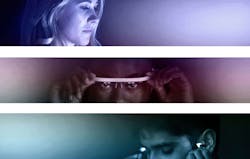Biophilia was coined by Erich Fromm in 1964 as "love of life" and further refined by Edward O. Wilson in 1984 to mean “the rich, natural pleasure that comes from being surrounded by living organisms.” We have long recognized our connectedness with nature, but consideration of human-centric design expands the potential for our built environment to enhance the human experience and even our well-being.
Designers are turning to human-centric design with increasing popularity through introducing green space, biomimicry, and tunable lighting to improve the well-being of those in their space.
While office buildings, residences and healthcare facilities have led the charge in exploring the potential benefits of biophilia through lighting, we can begin to imagine the potential benefits of biophilia in other parts of our lives including travel — an airport, for instance, that taps into the relationships between humans and light to fight the dreaded jet lag slump. Air travel often generates considerable stress for travelers of all experience levels. A large component of this stress can be traced to disruption of the body’s 24-hour internal clock, or circadian rhythm. Time spent in airports and airplanes directly impacts the passenger’s internal circadian clock. These closed, man-made environments disrupt the typical time-synchronizing cues the body receives from the environment, of which light is the most prominent.
Incorporating tunable lighting into airports reduces travel-related fatigue and brings the well-being of passengers into greater focus.
How it works
When daylight is present it produces stimulation or circadian entrainment, boosting our energy level and informing us when to be awake or to sleep. In airports, many of these cues are missing or out of order as passengers receive the wrong sequence of light temperatures and intensities. Regardless of time of arrival, a typical passenger is met with sterile cool lighting when arriving at the airport and passing through security. Passengers also experience shifts in their circadian rhythm when they travel to different time zones, leaving them fatigued and less productive or alert. The disruption created by passing through multiple time zones can cause indigestion, irritability and headaches in addition to travel induced malaise.
Tunable lighting offers a potential solution and affords lighting more appropriate for a passenger at each point in their travel journey. Currently, tunable lighting fixtures intended to promote entrainment effects are fairly rare and often only found in some healthcare facilities and office spaces. More prevalent are individual user products marketed as light therapy or targeted to enhance travel by prompting impulse boosts to our natural rhythm. These products vary from LED light boxes and glasses with built-in LEDs, to earbuds offering intracranial illumination. These products present light to our brains differently than the standard overhead light fixture.
Through tunable lighting, each area can be adjusted to the temperature and intensity of the intended experience associated with that space as well as how it should relate to the circadian rhythm. For example, locations which we would naturally associate with greater energy levels and wakefulness would require higher intensity light of a cooler blue-white color temperature, whereas a location we would naturally associate with restfulness or sleep would require a dimly lit space with a warmer color temperature. Lighting in various functional spaces needs to be treated both independently and holistically in order to produce the best overall experience for users.
Corgan conducted an experiment, a limited user experience, as part of an ongoing exploration of comprehensive design approaches and technology implementations. The objective was to collect first-hand data on a few individual light therapy products intended to be used as phasic “boost” solutions for minimizing the disruption to our internal rhythm and determine strategies to best apply the findings to the built environment.
Utilizing members of its aviation team, Corgan tested three popular product types (eyewear, intracranial illumination earbuds, and a light box) and documented the results. Participants ranged from 20 to 60 years of age and were approximately 44 percent male and 56 percent female. Fifty percent of participants expressed they had some rudimentary knowledge of the purported benefits of light therapy products prior to engaging in the experiment. For the light box and intracranial illumination earbuds, participants were instructed to follow the product instructions over a three-day period. For the eyewear, participants utilized the product user instructions paired with a phone app while traveling. Surveys were conducted after each day of product use highlighting how users experienced changes in their mood, sleep quality, alertness, focus, energy and ability to follow the product schedule as described.
Results varied with most participants feeling a positive impact from the technology but being inconvenienced by the intensity, time duration, schedule, maintenance and/or appearance. To reduce the number of obstacles and for these technologies to work best, they would need to be seamlessly integrated into the built environment. However, in an airport terminal, such a solution requires simultaneously meeting the needs of several different types of passengers and destinations.
Airport Integration
The complexity of lighting design for an airport increases when accounting for the unintended consequences that travel has on passengers. Creating a design solution that benefits diverse passenger needs and reduces negative impacts during travel requires a holistic approach to lighting in terminals — one that reboots our circadian rhythm through integration of tunable lighting with dynamic adjustability.
Starting at check-in areas in the airport, light color temperature and intensity can be automatically adjusted to match the time zone of the airport’s location. This prevents passengers arriving in the pre-dawn hours from receiving a disruptive shock to their circadian rhythm before beginning their journey. Instead, entry to the airport can be accompanied by calming light that seamlessly continues the passenger’s circadian rhythm without interruption. Applying the same lighting principles to the baggage claim areas helps passengers to begin adjusting to their new location before they even leave the building.
Offering "layered" lighting through the terminal provides passengers the opportunity to better control their experience at every point of travel. Long, midday layovers for passengers traveling to the opposite time zone could be improved with a low, warmly lit space to spend downtime. Keeping this light temperature closer to 2,700 Kelvin has the benefit of mimicking the domestic quality of light in a living room and further encourages relaxation and stress reduction. Beyond helping the passenger, this has the potential to provide a better environment for airport employees, who are also susceptible to the same disruption to their circadian rhythm. For example, dynamically tuning workspace lighting to simulate the ideal circadian rhythm (cycling from 2,500 Kelvin to 6,500 Kelvin) could improve alertness, help sleeping patterns and put workers at less risk for chronic disorders associated with reversed sleep-wake cycles. The implications of considering both passenger and staff needs has the potential to increase airport revenue and decrease sick leave and ‘loss of productivity’ costs.
"Wake up" concessions and amenities, such as coffee kiosks and smoothie stops should offer bright blue light that provides an energy boost while groupings of lower lit, sit-down restaurants and lounge amenities will appeal to those needing rest or relaxation. Zoning concessions of these varieties together helps subconsciously lead passengers to the decision that best benefits their health and wellbeing —allowing passengers to personalize their experience, improving satisfaction and driving sales. As demonstrated with the introduction of electrochromic tinting glass and other means of adjusting daylight, passengers who subliminally experience greater levels of comfort are more likely to dwell and increase spending. Through incorporation of tunable lighting, this enhanced comfort can permeate the terminal beyond those areas directly receiving daylight and increase profit airport-wide.
Some commercial airlines have already begun incorporating circadian lighting in their aircraft to help passengers better adapt to their destination’s time zone. In these aircraft, light temperature and intensity changes throughout international flights encourage passengers to adjust sleep schedules and arrive well-rested. This improvement to the traveler’s wellbeing can also be seamlessly extended and complimented within the terminal prior to departure. By dynamically tuning each gate’s lighting to correspond with the appropriate time zone of its destination, passengers can begin to adjust their internal clocks even before boarding.
Lounges have long prioritized a culture of hospitality within their spaces. Consideration of circadian rhythm and tunable lighting takes the hospitality aspect beyond the superficial nature of luxurious finishes and extends it to include the consideration of overall health and well-being. Introducing tunable lighting and individualized light products can help passengers choose to rest or boost energy pre- or post-flight, bringing the power of adjustment to the individual. Personalized rooms or pods can be designed to allow individuals to enter their flight number and receive a private and personalized light therapy session specific to their itinerary.
The aviation industry has only begun to explore the possibilities of circadian entrainment and tunable lighting. Though lighting may not be able to completely diminish jet lag, considering circadian rhythm taps into our inextricable connection to nature and the world around us — offering the potential to revolutionize the passenger experience in our increasingly global lives.
Ginger has been instrumental in expanding Corgan’s airport and airline customer-facing design expertise, with the recent rollout of the Delta One projects, a luxury check-in/processing area dedicated to Delta’s most elite travelers, as well as numerous American Airlines Admirals Clubs and two new premier American Express Centurion Lounge projects. Her experience with creating branded environments has helped achieve greater revenue opportunities in several international airports and the development and implementation of system-wide airline initiatives will directly benefit this project. Ginger has developed a unique ability to draw out the vision of the client and translate that into functional and beautiful designs that satisfy the client and users alike.
Beth Schmidt is an award-winning designer and artist. Her experience has ranged from boutique retail concessions to million square foot concept terminals and renovations. Her concentration on aviation design stems from her desire to create impactful spaces that influence individuals and redefine their experiences. She reinvigorates spaces by providing exceptional passenger experience through design, innovation, and technology.





